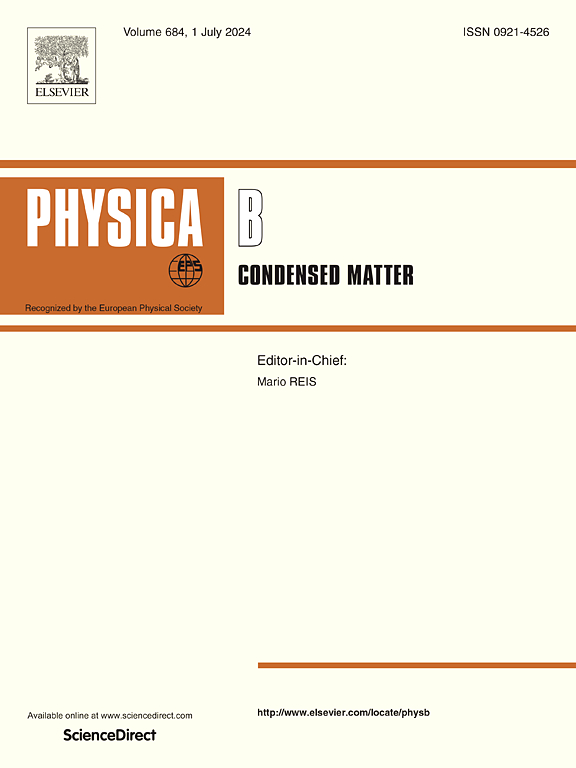Investigation on crystal structure, electronic and optical properties of V-rich V3X (X = Al, Si, Ge) Heusler alloys
IF 2.8
3区 物理与天体物理
Q2 PHYSICS, CONDENSED MATTER
引用次数: 0
Abstract
The vanadium-rich Heusler alloys V3X (X = Al, Si, Ge) have been synthesized and investigated. The crystal structure, optical and electronic structures were studied and compared. Using X-ray diffraction analysis, it was found that V3Al alloy has the D03 structure, and the V3Si and V3Ge compounds have the A15 one, also called the β-tungsten structure. It was shown that depending on both the p-element and crystal structure alloys exhibit different properties. The V3Al alloy crystallized in the D03 structure is characterized by the electronic structure of a gapless semiconductor with vanadium magnetic moments equal to 1.36(−1.36) μB completely compensated zero total magnetic moment, whereas, V3Si and V3Ge crystallized in the A15 structure exhibit metallic properties with zero magnetic moments. The optical characteristics of V3X (X = Al, Si, Ge) were studied for the first time using the ellipsometry method. The optical conductivity of the alloys was found to be mostly produced by transitions involving V 3d electrons, was found in good agreement with the theoretical results reproducing specific features of each alloy.
富v V3X (X = Al, Si, Ge) Heusler合金的晶体结构、电子和光学性能研究
合成并研究了富钒Heusler合金V3X (X = Al, Si, Ge)。对晶体结构、光学结构和电子结构进行了研究和比较。通过x射线衍射分析,发现V3Al合金具有D03结构,V3Si和V3Ge化合物具有A15结构,也称为β-钨结构。结果表明,根据p元素和晶体结构的不同,合金表现出不同的性能。在D03结构中结晶的V3Al合金具有无间隙半导体的电子结构,其钒磁矩为1.36(−1.36)μB,完全补偿了零总磁矩,而在A15结构中结晶的V3Si和V3Ge合金具有零磁矩的金属性质。本文首次用椭偏法研究了V3X (X = Al, Si, Ge)的光学特性。发现合金的光学导电性主要由涉及v3d电子的跃迁产生,与理论结果一致,再现了每种合金的特定特征。
本文章由计算机程序翻译,如有差异,请以英文原文为准。
求助全文
约1分钟内获得全文
求助全文
来源期刊

Physica B-condensed Matter
物理-物理:凝聚态物理
CiteScore
4.90
自引率
7.10%
发文量
703
审稿时长
44 days
期刊介绍:
Physica B: Condensed Matter comprises all condensed matter and material physics that involve theoretical, computational and experimental work.
Papers should contain further developments and a proper discussion on the physics of experimental or theoretical results in one of the following areas:
-Magnetism
-Materials physics
-Nanostructures and nanomaterials
-Optics and optical materials
-Quantum materials
-Semiconductors
-Strongly correlated systems
-Superconductivity
-Surfaces and interfaces
 求助内容:
求助内容: 应助结果提醒方式:
应助结果提醒方式:


